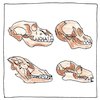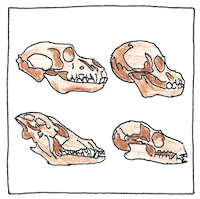Georges Cuvier, John Hunter
comparative anatomy

|
Comparative anatomy
With John Hunter, a Scottish surgeon, Georges Cuvier, a.k.a. Jean Léopold Nicolas Frédéric a.k.a. Dagobert, the Baron Cuvier escaped the guillotine during the French revolution and co-founded comparative anatomy. Realizing the structural similarity of all vertebrates, Cuvier was able to reconstruct extinct animals from fragments of their fossilized bones. Working from a lithograph of the skeleton of the extinct megatherium, Cuvier demonstrated that the animal was a giant ground sloth. From fossils found in the strata under Paris, Cuvier reconstructed the Palaeotherium an animal like a tapir.
A genius of his time
Cuvier was a great naturalist and a scientist of great breadth. Against the notion that God’s creation was perfect Cuvier established the fact that land animals had become extinct. With Alexandre Brongniart, independently of the work of William Smith, Cuvier discovered the principle of faunal succession to correlate layers of sedimentary rock. He collected his work on mollusks in 1812 as Mémoires pour servir à l’histoire et à l’anatomie des mollusques. With Achille Valenciennes, Cuvier wrote Histoire naturelle des poissons, describing 5000 species of fishes, Cuvier’s work for 30 years. Cuvier identified and named the first known pterosaur and was the first to propose an age when reptiles not mammals dominated the earth. Cuvier published work on the skeletons of living mammals, the rhinoceros, tapir, hippopotamus, sloth, and manatee. Cuvier published work on the skeletons of extinct mammals, the megalonyx, megatherium, cave-hyena, cave bear, and mastodon. Cuvier published and co-published lectures on anatomy and classification, Tableau élémentaire de l’histoire naturelle des animaux and Leçons d’anatomie comparée. Cuvier’s principle of correlation of parts is essential in both comparative anatomy and paleontology. However, Cuvier was implacably against any theory of evolution, he was a monogenist, believing everyone descended from Adam but that the “yellow and black races” diverged and were inferior, and he was a proponent of catastrophist geology.
Only bones
If a bone were sticking out of the skin of your arm my diagnosis would be clear, but if the same broken bone were dug up in my yard by a dog I wouldn’t know it to be human. The Sami people have hundreds of words for snow. Any educated person has similar useful refinements. You would be surprised by the number of useless things I have learned working for a big company for thirty years. Only a great deal of back-story could put flesh on those bones and the value of the endeavor would not be clear.



Cuvier escaped the guillotine, but not all the pervasive falsehoods of his time. He realized that animals had become extinct, against the popular notion that they would be found in a remote southern jungle, but could not embrace evolution, at least as explained by Lamarck (nor can we), and he was influenced by the racist attitudes and religious teachings of his time.
See also in The book of science:
Readings in wikipedia: